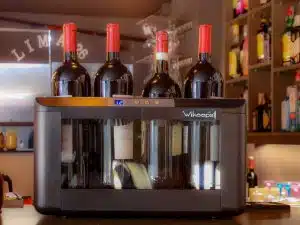The wine fridges, the other name for wine cellars.
Some people even go so far as to call wine fridges wine cellar fridges, which has the merit of being doubly explicit.
This piece of refrigerated furniture is both a fridge with a thermostat and a wine cellar insofar as the wine requires some particular parameters of ageing or service
What is better to choose between wine fridges or a regular fridge?
The wine fridges are dedicated to wine, in that it has some characteristics that differ from the classic fridge.
It is generally designed to make as little vibration as possible, as wine does not like vibrations.
It usually has a solid door or a dark glass door to protect the bottles from UV rays and has only a small LED light for the same reasons.
It offers a hygrometry close to 75% to allow a good conservation of the cork. Indeed, the cork is a living material which needs this rate in order to breathe and avoid developing mouldy odours and rotting over the years.
In the same way, the wine fridge generally has filters to avoid the development of any odours inside the cabinet. This will not be true if you try to store wine in a classic fridge ….
This being said, nothing prevents you from putting your red wine in the fridge before opening it, but then you’ll come across another problem: the temperature of the wine!
Wine fridges are the only tool for controlling wine temperature.
Whatever its size or use, it is the only way to bring you the essential parameter in wine service: the ideal temperature.
There are wine fridges which are conservation cellars; they are generally of large capacity (wine cellar with 100 bottles) with wooden shelves, full door to avoid the light.
They sometimes take on the appearance of a vintage 1 door fridge, which makes them a nice piece of furniture, even in the middle of the living room.
They are set to 12°C which is a good temperature for storing wine. But when it comes to serving wine, 12°C is not the ideal temperature for all wines.
White wines are best served at around 9°C, depending on the grape variety, so it’s too hot.
Putting them on ice or in the fridge is a solution, but how do you know when 9°C has been reached for tasting?
Putting them on ice soaks the label and requires a seal and a liteau… not easy!
Red wines should be drunk around 15-16°C for light red wines and up to 18°C for wines served at room temperature.
Here again, 12°C is too cool and the temperature will depend on the ambient temperature where the wine is served.
There are wine cabinets that are serving cellars and will be multi-zone, therefore multi-temperature.
They will allow the wine to be served at the right temperature by setting them to 9°C and 14°C for example.
Often the service cellar is a built-in wine fridge, so that it can be kept on hand at the bar or in a room where wine tasting is being prepared.
New, the wine fridges that you can out on a counter : the counter-top wine cellars!
Recently, new wine fridges have appeared. Smaller, cheaper, less bulky, they are the countertop wine cellars.
These cellars are mini fridges for wine which are placed on the work surface of the bar or your kitchen.
They exist in 2 bottles up to 8 & 12 bottles and also offer to work in mono temperature or in multi temperature.
The bottles are inserted from the top of the cellar and are free standing, with a glass window showing the chilled labels and LED lights making a nice display of the wine.
They have several advantages for wine lovers and professionals alike: these mini wine fridges are mobile, fairly light, compact and offer an elegant presentation for bottles on the wine by the glass or by the glass.
Certainly, the wine cellar comes in all shapes and sizes… so what is your need?

